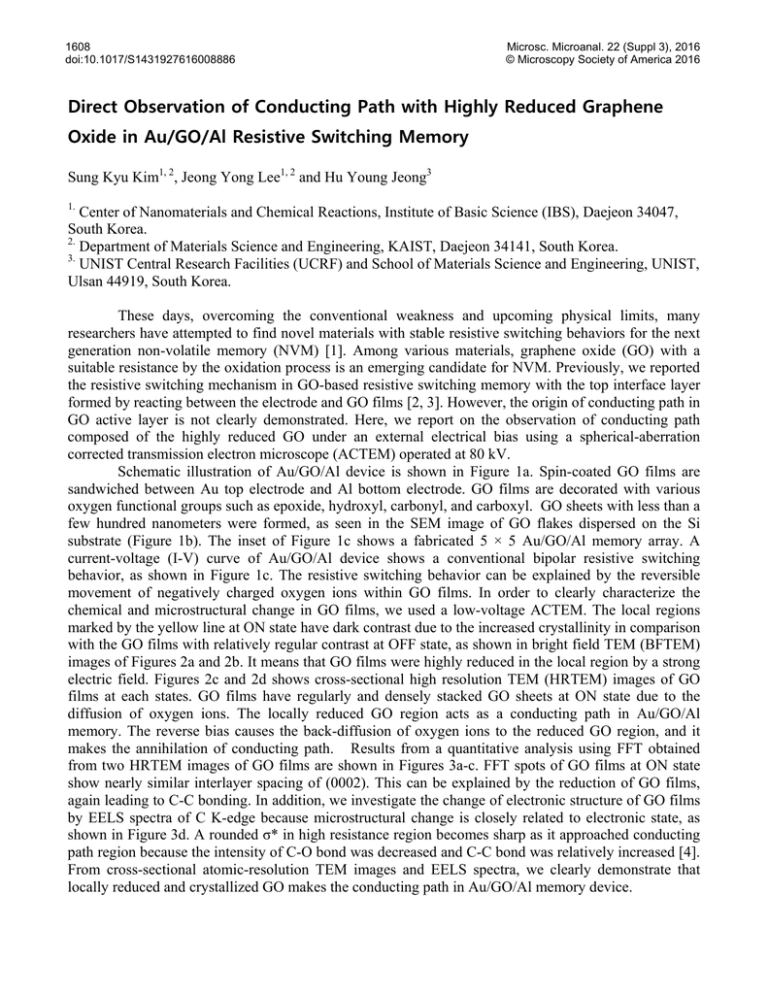Direct Observation of Conducting Path with Highly Reduced
advertisement

1608 doi:10.1017/S1431927616008886 Microsc. Microanal. 22 (Suppl 3), 2016 © Microscopy Society of America 2016 Direct Observation of Conducting Path with Highly Reduced Graphene Oxide in Au/GO/Al Resistive Switching Memory Sung Kyu Kim1, 2, Jeong Yong Lee1, 2 and Hu Young Jeong3 1. Center of Nanomaterials and Chemical Reactions, Institute of Basic Science (IBS), Daejeon 34047, South Korea. 2. Department of Materials Science and Engineering, KAIST, Daejeon 34141, South Korea. 3. UNIST Central Research Facilities (UCRF) and School of Materials Science and Engineering, UNIST, Ulsan 44919, South Korea. These days, overcoming the conventional weakness and upcoming physical limits, many researchers have attempted to find novel materials with stable resistive switching behaviors for the next generation non-volatile memory (NVM) [1]. Among various materials, graphene oxide (GO) with a suitable resistance by the oxidation process is an emerging candidate for NVM. Previously, we reported the resistive switching mechanism in GO-based resistive switching memory with the top interface layer formed by reacting between the electrode and GO films [2, 3]. However, the origin of conducting path in GO active layer is not clearly demonstrated. Here, we report on the observation of conducting path composed of the highly reduced GO under an external electrical bias using a spherical-aberration corrected transmission electron microscope (ACTEM) operated at 80 kV. Schematic illustration of Au/GO/Al device is shown in Figure 1a. Spin-coated GO films are sandwiched between Au top electrode and Al bottom electrode. GO films are decorated with various oxygen functional groups such as epoxide, hydroxyl, carbonyl, and carboxyl. GO sheets with less than a few hundred nanometers were formed, as seen in the SEM image of GO flakes dispersed on the Si substrate (Figure 1b). The inset of Figure 1c shows a fabricated 5 × 5 Au/GO/Al memory array. A current-voltage (I-V) curve of Au/GO/Al device shows a conventional bipolar resistive switching behavior, as shown in Figure 1c. The resistive switching behavior can be explained by the reversible movement of negatively charged oxygen ions within GO films. In order to clearly characterize the chemical and microstructural change in GO films, we used a low-voltage ACTEM. The local regions marked by the yellow line at ON state have dark contrast due to the increased crystallinity in comparison with the GO films with relatively regular contrast at OFF state, as shown in bright field TEM (BFTEM) images of Figures 2a and 2b. It means that GO films were highly reduced in the local region by a strong electric field. Figures 2c and 2d shows cross-sectional high resolution TEM (HRTEM) images of GO films at each states. GO films have regularly and densely stacked GO sheets at ON state due to the diffusion of oxygen ions. The locally reduced GO region acts as a conducting path in Au/GO/Al memory. The reverse bias causes the back-diffusion of oxygen ions to the reduced GO region, and it makes the annihilation of conducting path. Results from a quantitative analysis using FFT obtained from two HRTEM images of GO films are shown in Figures 3a-c. FFT spots of GO films at ON state show nearly similar interlayer spacing of (0002). This can be explained by the reduction of GO films, again leading to C-C bonding. In addition, we investigate the change of electronic structure of GO films by EELS spectra of C K-edge because microstructural change is closely related to electronic state, as shown in Figure 3d. A rounded σ* in high resistance region becomes sharp as it approached conducting path region because the intensity of C-O bond was decreased and C-C bond was relatively increased [4]. From cross-sectional atomic-resolution TEM images and EELS spectra, we clearly demonstrate that locally reduced and crystallized GO makes the conducting path in Au/GO/Al memory device. Microsc. Microanal. 22 (Suppl 3), 2016 1609 References [1] G. I. Meijer, Science 319 (2008), 1625 [2] H. Y. Jeong, et al., Nano Lett. 10 (2010), 4381 [3] S. K. Kim, et al., Adv. Funct. Mater. 25 (2015), 6710 [4] K. A. Mkhoyan et al., Nano Lett. 9 (2009), 1058 [5] This work is supported by NRF-2014R1A1A2058713 and IBS-R004-G3. Figure 1. (a) Schematic illustration of Au/GO/Al device. (b) SEM image of GO sheets dispersed on Si substrate. The inset is a magnified SEM image of the yellow rectangular region (scale bar: 100 nm). (c) Typical I-V curve of Au/GO/Al device plotted on a semilogarithmic scale. The bias was applied along the arrows. The right inset is an optical image of the device. Figure 2. Cross-sectional BFTEM images of Au/GO/Al device at (a) OFF state and (b) ON state. Crosssectional HRTEM images of GO films at (c) OFF state and (d) ON state. Figure 3. (a) and (b) are FFT patterns obtained from (c) and (d) in figure 2, respectively. (c) The intensity profiles of the RDF from the center to a desired radius in the FFTs acquired from (a) and (b). (d) Coreloss-EELS spectra of the C K-edge from the different regions in ON state GO films.





